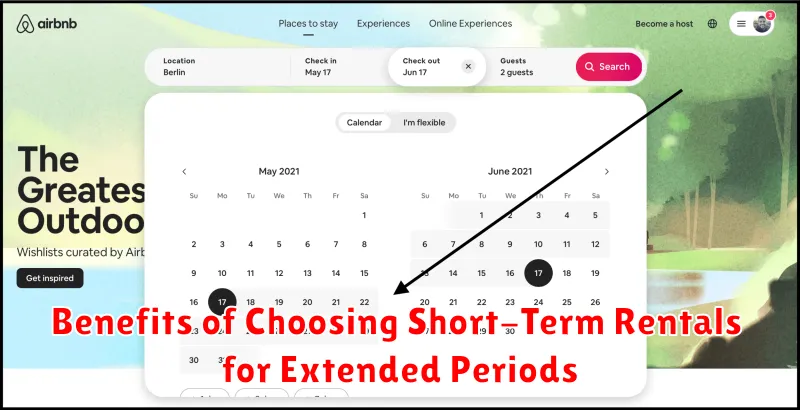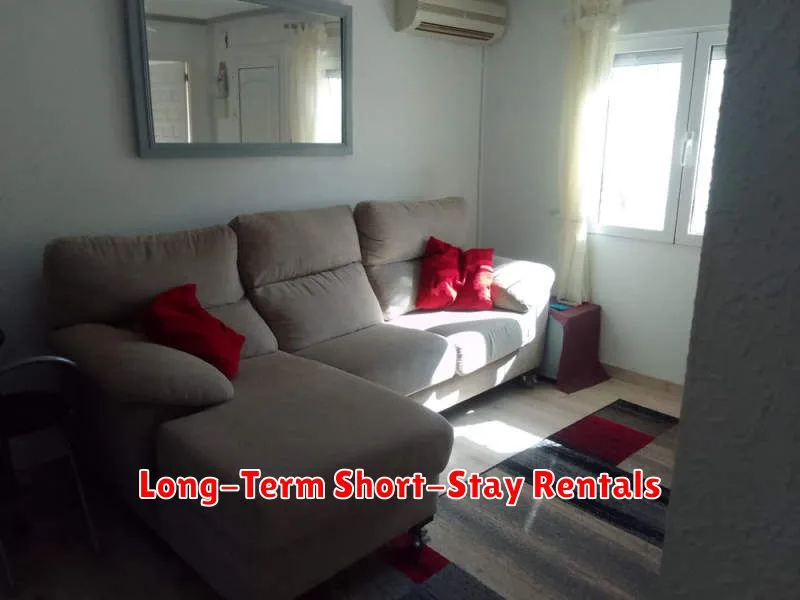Planning a long-term stay in a short-term rental? It might sound tricky, but with the right approach, you can find the perfect extended stay solution. This guide will walk you through everything you need to know, from finding the ideal property and negotiating a favorable long-term rental agreement to understanding the costs and ensuring a smooth, comfortable extended stay in a short-term rental. Whether you’re relocating for work, a renovation project, or simply seeking a flexible housing option, discover how to make your long-term short-term rental experience a success!
Introduction: Why Long-Term Stays in Short-Term Rentals Work
Finding the perfect temporary home can be tricky, especially for extended stays. Traditional rentals often require long-term leases and lack the flexibility needed for temporary situations. Short-term rentals, typically associated with vacations, offer a compelling alternative for those needing long-term accommodations.
Flexibility is a key benefit. Unlike a year-long lease, short-term rentals allow you to customize your stay duration, providing greater control and the ability to adapt to changing circumstances. This is especially beneficial for those relocating, undergoing renovations, or working on temporary projects.
Furnished properties are standard with short-term rentals, eliminating the hassle and expense of furnishing a new space. Many rentals offer amenities like laundry facilities, Wi-Fi, and even kitchen essentials, making your move-in seamless and convenient. This makes them particularly attractive for those who want to avoid the complexities and costs associated with moving or setting up a new home.
While the cost per night might seem higher initially, negotiating a discounted monthly rate is often possible for longer stays. When factoring in the benefits of furnished accommodations, built-in amenities, and the flexibility offered, a short-term rental can prove to be a cost-effective and convenient solution for long-term temporary housing needs.
Benefits of Choosing Short-Term Rentals for Extended Periods

While traditional long-term leases offer stability, short-term rentals provide unique advantages for extended stays. One key benefit is flexibility. Unlike a year-long lease, you’re not locked into a contract, allowing you to adjust your stay based on changing needs or circumstances.
Furnished properties are a significant draw. Short-term rentals are typically fully furnished, eliminating the hassle and expense of buying or moving your own furniture. This is particularly beneficial for those relocating temporarily or needing a fully equipped space quickly.
Amenities often surpass those found in standard apartments. Many short-term rentals offer upgraded amenities such as pools, gyms, or high-speed internet, enhancing your comfort and convenience during your stay.
Location is another key factor. Short-term rentals are often available in desirable neighborhoods or close to specific work locations, offering a level of convenience not always found with long-term rentals.
Finally, better property management is often a perk. Many short-term rental companies offer robust customer service, quick maintenance responses, and a generally more responsive approach to tenant issues compared to traditional landlords.
How to Negotiate Long-Term Rates for Short-Term Properties
Securing a long-term stay in a short-term rental often requires negotiating a discounted rate. Direct communication with the property owner or manager is key. Avoid third-party booking sites for this, as they often lack flexibility.
Start by expressing your interest in a longer-term lease (e.g., 30, 60, or 90 days). Highlight the benefits to the owner, such as guaranteed income and reduced vacancy periods. Propose a specific rate that’s lower than the standard daily rate, justifying your offer based on market research and the length of your stay. Be prepared to negotiate.
Present a strong case. Explain your reliability as a tenant, highlighting your responsible nature and intention to maintain the property. Offering to pay a larger security deposit or paying upfront for a portion of your stay can also strengthen your negotiating position.
Remember to put everything in writing. Once you agree on a rate, confirm the terms in a formal agreement that outlines the rental period, the agreed-upon rate, payment schedule, and any other important conditions.
Be respectful and professional throughout the process. A positive and collaborative approach increases your chances of successfully negotiating a favorable long-term rate for your short-term rental.
Top Platforms to Find Extended Short-Term Rentals
Finding the perfect short-term rental for an extended stay requires exploring various platforms. Booking.com and Airbnb are popular choices, offering a wide selection of properties and often providing options for monthly or longer-term discounts. However, their focus on shorter stays might mean fewer options explicitly tailored for extended periods.
For a more specialized approach, consider platforms specifically designed for longer-term rentals. VRBO (Vacation Rentals By Owner) often lists properties suitable for stays of a month or more, frequently with more amenities and potentially better value for longer bookings. Furnished Finder and Extended Stay America (though more hotel-like) cater specifically to longer-term stays, offering more consistent rental terms and services.
When searching, be sure to filter your results by minimum stay to quickly eliminate unsuitable options. Read reviews carefully, paying attention to comments about suitability for extended stays, long-term amenities (like reliable internet), and the landlord’s communication style. Don’t hesitate to contact hosts directly to negotiate pricing and terms for longer stays; many are open to discounts for monthly or longer bookings.
What to Look for in a Long-Term Short-Term Stay
Planning a long-term stay in a short-term rental requires careful consideration. Location is key; ensure it’s convenient for your needs, considering commute times, proximity to amenities, and overall safety.
The property itself needs ample space for your belongings and comfortable living. Look for sufficient storage, a well-equipped kitchen if you plan to cook frequently, and a layout that suits your lifestyle. Reliable internet access is crucial for remote work or staying connected.
Lease terms and conditions are vital. Clarify the rental agreement, focusing on the length of stay, payment schedule, renewal options, and any restrictions. Understand the property’s rules regarding guests, pets, and maintenance responsibilities.
Utilities and their associated costs should be clearly defined. Determine who is responsible for paying for electricity, water, gas, and garbage disposal. Negotiate upfront if possible to secure a fair price and avoid unexpected expenses.
Finally, verify the property manager or owner’s responsiveness and reliability. Check reviews, contact references if possible, and ask about their process for addressing repairs or maintenance issues. A reliable contact person will ensure a smoother long-term stay.
Tips for Managing Utilities and Expenses
Staying in a short-term rental for an extended period requires a different approach to utility and expense management than a typical vacation stay. Careful planning is key to avoiding unexpected costs and budgetary surprises.
Negotiate utility rates upfront. Inquire about potential discounts for longer stays. Some property managers may offer reduced rates or bundled packages. Clarify whether utilities are included in the rental price or if you’ll be responsible for paying them separately.
Understand your usage. Consider your typical energy and water consumption habits. A longer stay means higher bills, so be mindful of conserving resources. This includes turning off lights, unplugging electronics, and limiting water usage.
Set a budget and track expenses. Create a realistic budget that includes utilities, groceries, transportation, and other daily expenses. Regularly monitor your spending to ensure you’re staying within your financial plan. Utilize budgeting apps or spreadsheets to track your progress.
Communicate with your property manager. Don’t hesitate to contact your property manager if you have any questions regarding utility payments, billing, or unexpected issues. Open communication can prevent potential problems from escalating.
Explore payment options. Ask about different payment methods for utilities and determine which is most convenient for you. Automatic payments can simplify the process and ensure bills are paid on time.
By proactively addressing utility and expense management, you can significantly reduce stress and ensure a more comfortable and financially responsible long-term stay in your short-term rental.
Conclusion: Combining Flexibility and Comfort
Planning a long-term stay in a short-term rental requires careful consideration of both flexibility and comfort. While short-term rentals offer the flexibility of shorter lease terms and potentially better locations, finding one that provides the comfort of a long-term residence takes effort.
By carefully researching properties, negotiating with hosts, and focusing on key factors such as amenities, location, and overall cost, you can successfully balance these competing needs. Remember to prioritize your must-haves, but also be open to compromises to find the perfect balance between a convenient and comfortable long-term stay.
Ultimately, finding the right short-term rental for an extended period is about finding a place that feels like home while offering the freedom and adaptability you need. With thorough planning and a bit of patience, you can enjoy the best of both worlds.

